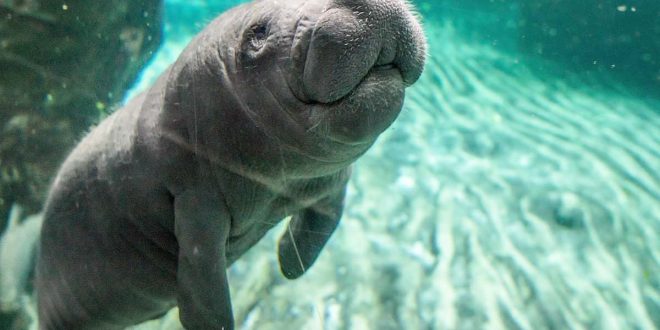Manatees have official been taken off the U.S Interior Department’s list of endangered species list.
Citing a growing population spawned by decades of work improving habitat and bolstering protections,US federal wildlife officials removed the manatee from the endangered species list Thursday.
The U.S. Fish and Wildlife Service has been pushing since last January to lower the designation for manatees from endangered to threatened. The move is a milestone. In years past, it appeared the mammals were on their way to extinction.
Last year, Florida wildlife officials found 6,620 manatees swimming in Sunshine State waters, a huge increase from when counts started in 1991. Back then only 1,267 were counted.
But the federal decision looked at increases in manatee populations throughout its range in the Caribbean, Gulf of Mexico and along the northern coast of South America. As many as 6,300 manatees live spread among the Antilles, Caribbean and South and Central America.
“While there is still more work to be done to fully recover manatee populations, particularly in the Caribbean, manatee numbers are increasing and we are actively working with partners to address threats,” said Jim Kurth, the U.S. Fish and Wildlife Service’s acting director. “Today we both recognize the significant progress we have made in conserving manatee populations while reaffirming our commitment to continuing this species’ recovery and success throughout its range.”
Federal protections will remain in place for manatees, which are migrating from their wintering grounds near warm-water outpours and coastal springs. The animals remain protected under the Marine Mammal Protection Act.
Salvaging manatee habitat has been one of the largest factors in the species’ comeback. FWS, in its assessment, said the biggest issues the species will continue to face are habitat loss, degradation and fragmentation of habitat, collisions with watercraft, loss of wintering grounds and poaching.
Limiting collisions with boats is the main objective laid out in FWS’s Florida manatee recovery plan, but the most significant effort is maintaining habitat that can support the growing population. Conserving wintering areas ripe with foraging grasses remain the focus for habitat restoration in the state.
Nick Wiley, Florida Wildlife Conservation Commission executive director, said efforts will continue to strengthen the coastal habitats manatees call home and share with humans. Downlisting gives credence to the work that has been put in so far.
“The Florida Fish and Wildlife Conservation Commission, the U.S. Fish & Wildlife Service and many partners and citizens have worked collaboratively for years to increase the abundance and health of Florida manatee populations, resulting in a great conservation success story,” Wiley said in a statement. “Given their continuing recovery, FWC supports a reclassification of manatees to threatened and remains committed to working with our partners to maintain the thriving manatee population in Florida.”
Agencies/Canadajournal
 Canada Journal – News of the World Articles and videos to bring you the biggest Canadian news stories from across the country every day
Canada Journal – News of the World Articles and videos to bring you the biggest Canadian news stories from across the country every day



